Imagine a world where doctors can focus entirely on patient care—free from the burden of endless documentation.
Thanks to the best AI medical scribe solutions, this vision is now a reality, transforming healthcare with seamless, accurate, and efficient note-taking. Say goodbye to burnout and hello to smarter, faster clinical workflows.
But with so many options available, how do you find the right fit for your practice? Let’s break down the options and what makes each one stand out.
The Best AI Medical Scribe: Our Top Picks
After thorough research, these are the best AI medical scribe solutions worth trying for seamless documentation and enhanced efficiency.
1. Suki
Suki is a voice-enabled AI assistant designed specifically for healthcare providers. It listens to clinicians as they speak during or after a patient encounter and automatically generates medical notes.
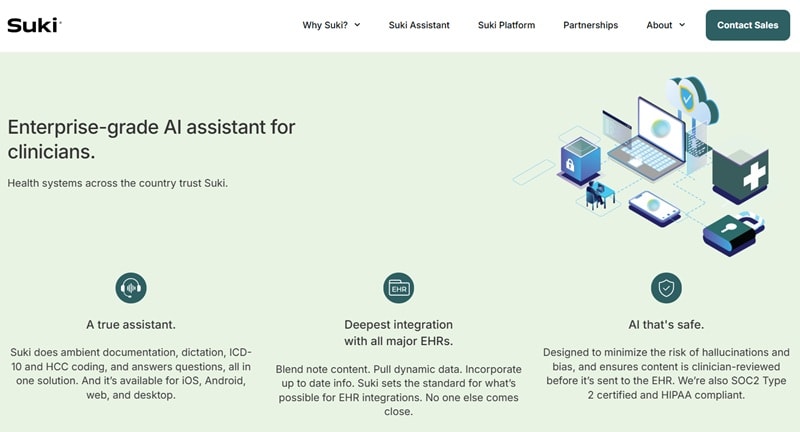
Suki stands out for its simplicity, speed, and high degree of EHR integration (notably with Epic and Cerner). It adapts to individual physician preferences over time, making documentation more personalized and efficient. Many physicians report 60-70% reductions in time spent on note-taking with Suki.
Pros
- Fast and accurate voice recognition.
- Learns and adapts to individual physicians.
- Integrates with major EHRs.
- Simple user interface
Cons
- Limited specialty customization compared to larger systems.
- Less suited for complex hospital workflows.
2. Nuance DAX (Dragon Ambient eXperience)
Developed by Nuance (now part of Microsoft), DAX is one of the most advanced AI medical scribes. It uses ambient listening technology to capture conversations during clinical encounters and automatically generates structured documentation.
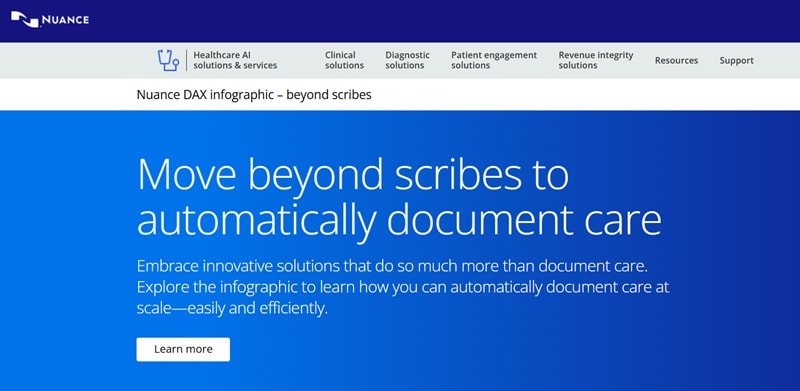
It’s designed for seamless EHR integration and prioritizes security and compliance. Its unique value lies in its use of AI combined with human-in-the-loop review, ensuring both speed and high accuracy. It's widely adopted in large health systems.
Pros
- Enterprise-grade, used in large health systems.
- Combines AI with human review for high accuracy.
- Deep EHR integration.
- Strong data privacy and security.
Cons
- Expensive for small practices.
- Requires more setup and infrastructure.
3. DeepScribe
DeepScribe offers an ambient AI medical scribe that passively listens to patient visits and produces complete SOAP notes. It uses advanced natural language processing and machine learning to extract relevant medical information.
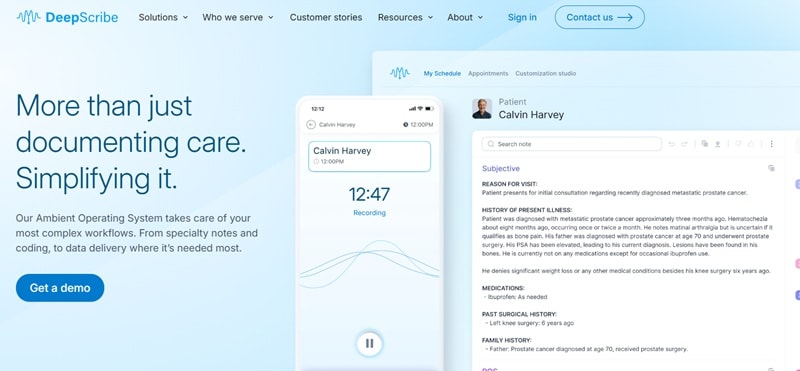
Its lightweight setup means it can be deployed via a mobile device or microphone in the room. DeepScribe integrates with major EHRs and is popular among private practices and smaller clinics due to its cost-effectiveness and minimal setup requirements.
Pros
- Affordable for small and medium practices.
- Hands-free and ambient listening.
- Quick to deploy with minimal hardware.
Cons
- Some EHR integrations may require custom setup.
- May need clinician review for complex cases.
4. Augmedix
Augmedix initially started as a service using Google Glass but has since evolved into a powerful ambient documentation platform that combines AI with remote human scribes.
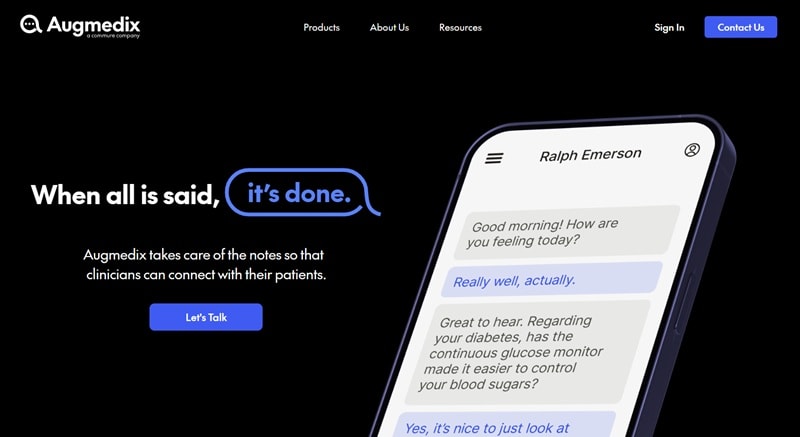
It captures audio from patient visits in real time, processes it with AI, and then human scribes refine the notes before final submission to the EHR.
This hybrid approach allows for very high accuracy while keeping documentation turnaround quick. It supports a variety of medical specialties and is used by both large hospitals and outpatient clinics.
Pros
- Hybrid AI + human model ensures high accuracy.
- Supports many specialties.
- Real-time processing with quick turnaround.
Cons
- Higher cost due to human-in-the-loop.
- Requires audio setup and strong internet connection.
5. Notable
Notable goes beyond just medical scribing—it’s a comprehensive automation platform for healthcare. While it includes AI-driven clinical documentation, it also automates check-ins, patient communications, and administrative tasks.
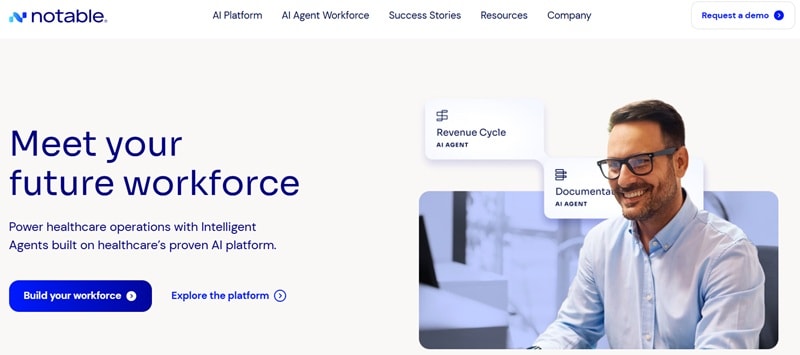
Its AI listens to physician-patient conversations, captures key details, and inserts structured data directly into the EHR. It’s designed for enterprise-level efficiency, supporting system-wide automation across entire health networks.
Pros
- Covers clinical, operational, and administrative workflows.
- Automates entire patient journey, not just notes.
- Works well across enterprise health systems.
Cons
- Overkill for solo practitioners or small clinics.
- Heavier integration process.
6. Abridge
Abridge is known for its consumer-facing app but also offers a clinician-focused solution that transforms conversations into medical documentation. It emphasizes transparency and control, letting clinicians review and edit notes before they are finalized.
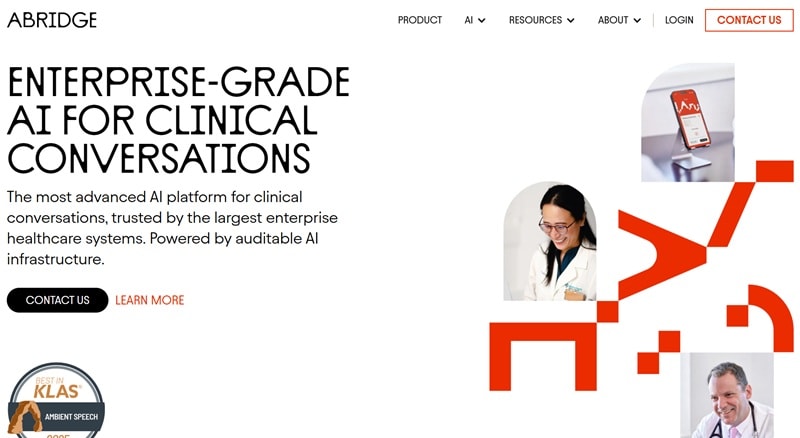
Abridge excels in generating well-structured summaries with links back to the exact part of the conversation for context. It’s useful both in-person and in telehealth settings, and it's increasingly being adopted by providers for ambient note-taking.
Pros
- Clear summaries with contextual links.
- Good for both in-person and telehealth.
- Easy for clinicians to review and edit.
Cons
- Still growing its enterprise features.
- May lack deep customization for certain specialties.
7. Tali AI
Tali AI is a voice-enabled medical assistant designed to work alongside EHR systems.
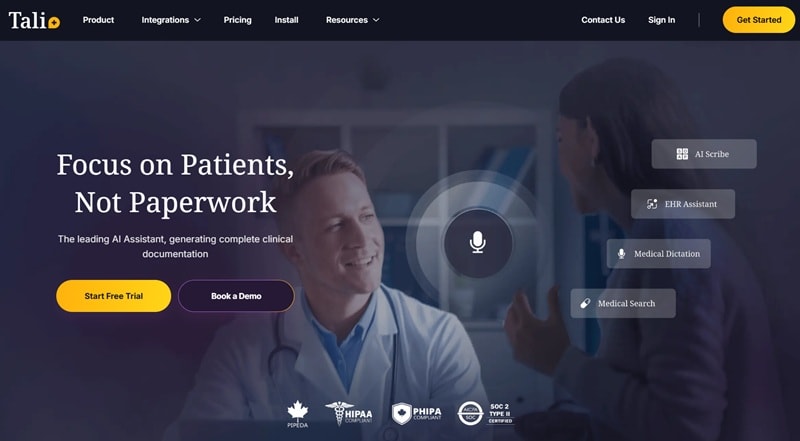
Physicians can ask it to take notes, retrieve patient information, or order tests using natural language. It acts more like an in-consultation assistant rather than a purely ambient scribe.
Pros
- Voice-first interface is intuitive.
- Supports clinical queries (e.g., “What’s the latest lab result?”).
- Integrates with some major EHRs.
- Can be used hands-free.
Cons
- Limited ambient scribing compared to others.
- Still expanding EHR integrations.
- Best suited for English-speaking regions.
8. Nabla
Nabla offers a lightweight AI scribe that can join consultations (including telehealth) and generate structured clinical notes.
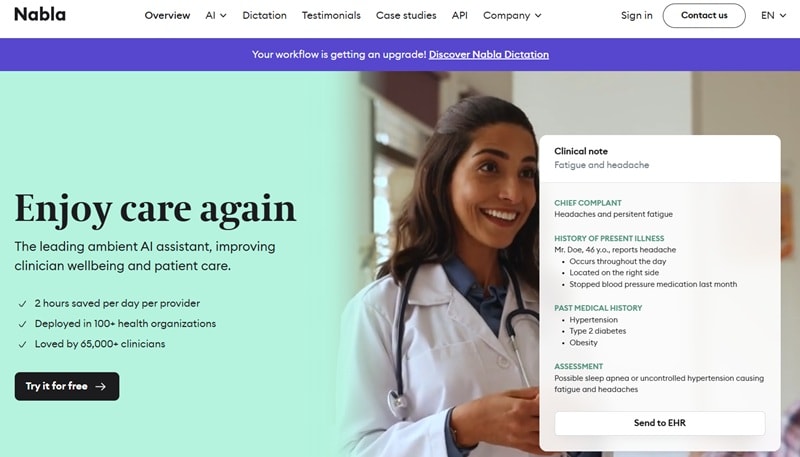
It emphasizes ease of use and fast deployment, especially in smaller practices and startups.
Pros
- Real-time, automated note generation.
- Clean, user-friendly interface.
- Supports both in-person and virtual visits.
- Free or low-cost tiers for small teams.
Cons
- Less robust EHR integration than larger players.
- Some limitations in medical specialty coverage.
9. SOAP Health
SOAP Health focuses on enhancing patient intake and pre-visit data collection using AI.
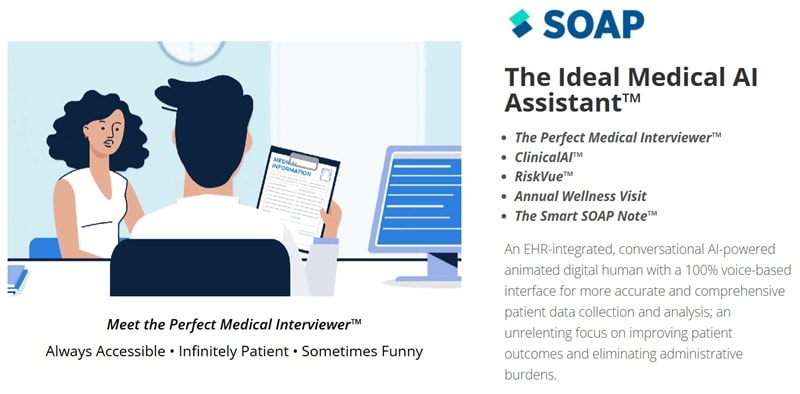
It helps gather comprehensive histories, symptoms, and risk factors before the clinician encounter, and can assist in generating SOAP notes.
Pros
- Deep patient data collection before appointments.
- Helps improve diagnostic accuracy.
- Integrates well with some telehealth workflows.
Cons
- Not a real-time ambient scribe.
- Focuses more on intake than during-visit transcription.
10. HealthNote
HealthNote automates the collection of clinical data from patients before their visit.
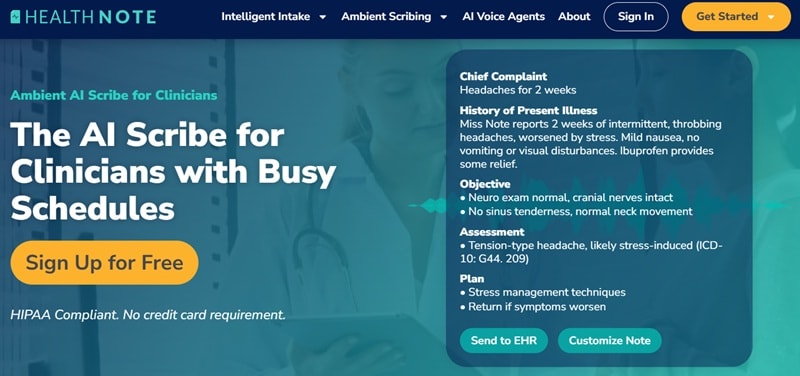
It uses smart forms and questionnaires, and turns the data into structured EHR-ready notes, reducing documentation burden during appointments.
Pros
- Speeds up intake and visit prep.
- Reduces time spent by physicians on documentation.
- Customizable templates and workflows.
Cons
- Focused mostly on pre-visit—not real-time ambient scribing.
- May require integration support for smaller clinics.
11. Saykara
Saykara developed an AI voice assistant (Kara) that captured and transcribed clinical conversations into structured notes.
Its technology is now part of Nuance DAX, but its original innovations continue to influence the product.
Pros
- Strong ambient documentation features.
- Focused on reducing physician burnout.
- Tailored for busy clinicians needing speed and efficiency.
Cons
- Discontinued as a standalone service after acquisition.
- Now absorbed into the broader Nuance ecosystem.
So, What Is the Best AI Medical Scribe?
The search for the best AI medical scribe isn't about finding the most advanced technology. It's about finding the right fit for your specific practice needs.
To simplify your search, we’ve matched top AI scribes to the real-world scenarios where they shine most.
🏥 Best for Large Hospitals & Health Systems
For hospitals juggling massive patient loads, the best AI medical scribe offers enterprise-grade scalability, EHR integrations, and multi-user support. Here are the top contenders:
- Nuance DAX – Enterprise-grade, highly accurate, deeply integrated with EHRs like Epic and Cerner.
- Notable – Automates more than just documentation, great for full workflow automation across departments.
- Augmedix – uses a hybrid model combining AI with human scribes, providing high accuracy and EHR integration, especially suitable for busy clinics and health systems.
🏠 Best for Small Clinics or Solo Practices
Smaller practices need an AI scribe that’s affordable, easy to deploy, and light on IT demands. These picks balance power and simplicity:
- Suki – Fast, affordable, easy to set up, minimal training needed.
- DeepScribe – Low-cost, strong ambient scribe with EHR compatibility.
- Nabla – Lightweight, intuitive, great for tech-savvy practitioners needing a fast deployment.
💻 Best for Telehealth and Remote Consults
Telehealth requires an AI scribe that works seamlessly across virtual platforms while capturing patient details accurately. These tools excel in remote settings:
- Abridge – Designed with telehealth in mind, generates notes with contextual audio links.
- Nabla – Works in both virtual and in-person settings, no complex setup required.
- HealthNote – Helps prep the visit with patient-reported data ahead of time.
🧾 Best for Automating Pre-Visit & Intake
Cut down on admin time with an AI scribe that automates forms, history-taking, and pre-visit paperwork. The standouts:
- HealthNote – Streamlines intake and generates structured notes from patient input.
- SOAP Health – Collects detailed patient history and symptoms to assist diagnosis.
- Notable – Automates the entire patient journey, including check-ins and forms.
🎙️ Best for Voice Commands & In-Consultation Help
For clinicians who want real-time assistance, the best AI medical scribe responds to voice commands and integrates smoothly into live appointments. Top performers:
- Tali AI – Real-time voice assistant for ordering, searching EHRs, and taking notes.
- Suki – Responsive to voice commands, learns preferences over time.
- Saykara (legacy) – Great foundation, now part of Nuance’s DAX.
Remember, the best AI medical scribe isn't the one with the most features. It's the one that integrates so smoothly into your workflow, you'll wonder how you ever practiced without it. Your perfect documentation partner is waiting.
Read Also











